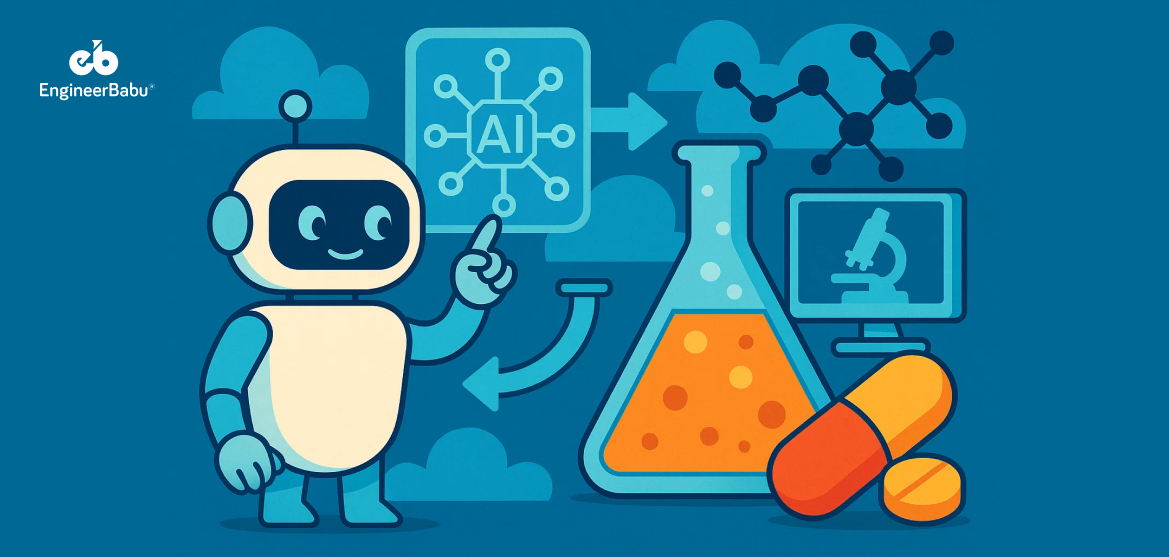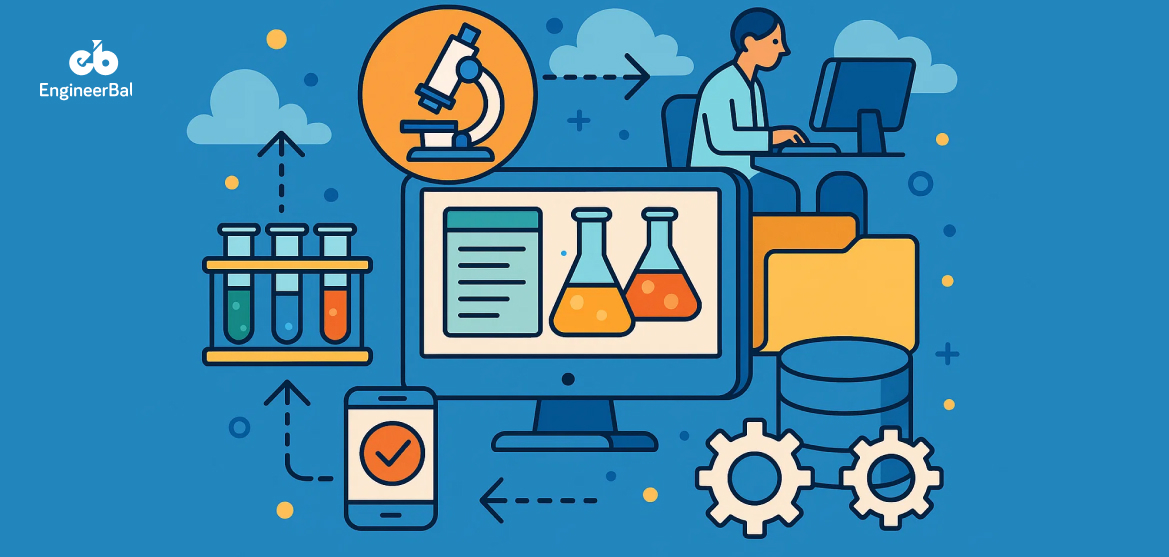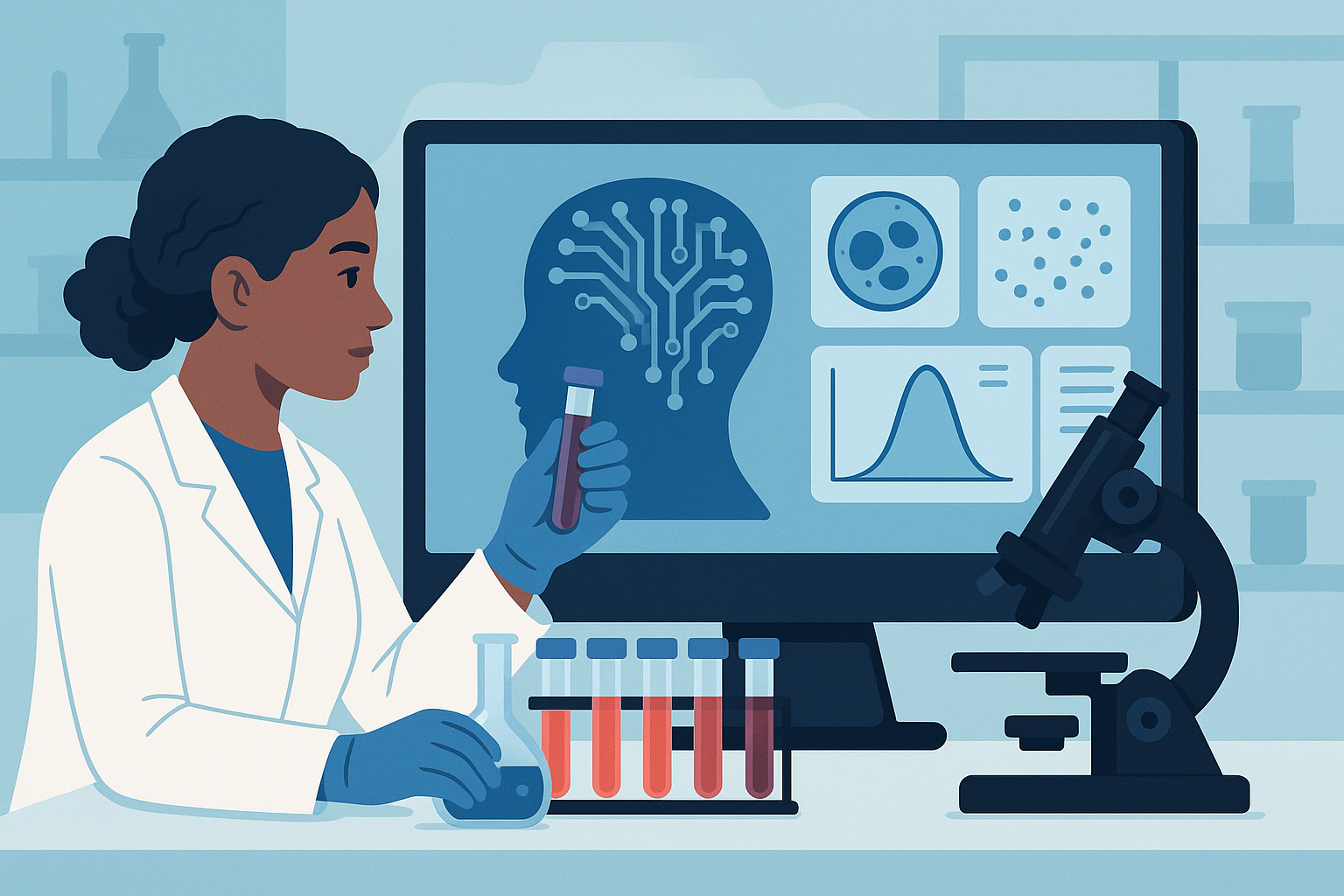AI in drug discovery is cutting down research time, slashing costs, and speeding up how fast new drugs reach patients.
It used to take over 10 years and more than $2 billion to bring a new drug to market. Now, AI models can screen millions of compounds in days, not months. McKinsey says AI could cut R&D costs by as much as 15% and accelerate early-stage drug discovery by up to 60%.
That’s why companies like Pfizer and AstraZeneca are investing millions in AI. And it’s not just the giants. Healthtech startups are getting in early and reaping big rewards.
In this article, we’ll cover the most powerful ways AI in drug discovery is flipping the script and how you can take advantage.
8 Ways AI in Drug Discovery is Transforming Pharma Industry
1. Accelerated Target Identification
AI is helping scientists spot disease-causing genes or proteins faster than ever. It used to take years of experiments to narrow down a single target. Now, machine learning models can scan genomic data, medical records, and scientific literature in a matter of days to suggest likely candidates.
One example comes from BenevolentAI. Their system surfaced a previously overlooked target for ALS, leading to a new clinical trial in record time. That kind of speed is no longer the exception.
This shift isn’t just about speed. AI also improves accuracy by considering far more variables than a human researcher can. It digs through millions of data points—some structured, others buried in PDFs—and connects patterns that would otherwise go unnoticed.
Instead of relying on manual searches and intuition, teams can now use AI to prioritize targets with real potential. It means fewer dead ends and more focus on leads that actually matter.
Want to see where else AI fits in pharma? Check out this guide on AI in the pharmaceutical industry.
2. Efficient Compound Screening
Finding the right compound used to be like searching for a needle in a haystack. Labs would test thousands of molecules in wet experiments to see which ones might work. It was slow, expensive, and wasteful.
AI flips that approach.
Machine learning models now predict which compounds are likely to bind to a target before anyone even steps into a lab. These models learn from past research—millions of molecular structures, chemical reactions, and biological outcomes—and use that to score new candidates.
For example, Atomwise uses deep learning to simulate how molecules interact with proteins. Their AI can scan over 10 million compounds in a few days, ranking them by how likely they are to work. That’s not just faster. It saves millions in research costs.
This kind of pre-screening helps narrow down the pool to a manageable set of promising compounds. So instead of testing thousands, you might only need to test 50. That’s a big deal when each lab test costs hundreds or thousands of dollars.
3. Precision Drug Design
Designing a new drug is more than picking a compound that works. It’s about crafting one that hits the target, avoids side effects, dissolves in the body properly, and lasts long enough to have an effect. That’s a tough list to check off using traditional methods.
AI simplifies this by generating molecules from scratch that meet all those needs.
Platforms like Insilico Medicine and DeepMind’s AlphaFold are leading this space. They use models trained on thousands of drug-like molecules and protein structures to create entirely new compounds tailored for specific diseases. In one case, Insilico designed a drug candidate in under 18 months. The usual timeline for this would be around 4 to 6 years.
AI also looks at properties like solubility, toxicity, and how a drug is processed in the body during the design phase. That helps avoid costly surprises later in development, like finding out a compound causes liver damage or doesn’t reach the intended tissue.
Another advantage is speed. When a compound shows promise but has flaws, the model can suggest adjustments instantly. Researchers can test dozens of improved versions in a single afternoon.
4. Repurposing Existing Drugs
Starting from scratch isn’t always the smartest option. Some of the most impactful drugs today were originally developed for entirely different uses. Thalidomide, for instance, was first marketed as a sedative but is now used to treat multiple myeloma and complications from leprosy.
AI makes this kind of drug repurposing faster and more targeted.
Instead of digging through trial data by hand, machine learning models scan clinical reports, biomedical studies, and patient records to find overlooked patterns. If a drug created for diabetes shows potential in treating neurological conditions, the system flags it.
Healx is already doing this. Their AI platform helped discover new uses for existing drugs to treat rare diseases. One of their findings went from idea to clinical trial in just 18 months.
Repurposing has huge upsides. These drugs have already cleared safety tests, so they can often skip early trial phases. That means shorter timelines, lower costs, and quicker delivery to patients.
5. Predicting Drug-Drug Interactions
Mixing medications can lead to serious problems. Some combinations cancel each other out, while others increase toxicity. Testing every possible interaction in a lab isn’t realistic, especially when thousands of drugs are already on the market.
But now, AI models can predict how one drug might interact with another by analyzing chemical structures, clinical data, and patient records. These predictions aren’t random guesses. They’re based on known metabolic pathways, shared protein targets, and real-world case reports.
For example, if two drugs are both broken down by the same liver enzyme, AI can flag the risk of one overpowering the other. That insight could prevent adverse effects before they happen.
Researchers are also using natural language processing to scan medical literature and extract documented interactions. When combined with patient-specific data, the model can even suggest which combinations are safer for certain age groups or people with underlying conditions.
This kind of foresight is a big deal for anyone working on combination therapies or expanding a drug’s use across different treatments. It helps avoid setbacks, reduces harm, and builds trust with regulators.
6. Optimizing Clinical Trials
Clinical trials are one of the most expensive and time-consuming parts of drug development. Recruiting patients, managing data, and running multiple trial phases can take years. And even after all that, many trials fail because of poor design or the wrong patient mix.
AI is starting to fix that.
With access to real-world data, like electronic health records and past trial results, AI models can predict how a trial will unfold before it even begins. They help pick the right trial sites, estimate recruitment timelines, and suggest eligibility criteria that improve enrollment and reduce dropout rates.
Some systems go even further. They simulate virtual trials to test different scenarios. For instance, what happens if you change the dosage or narrow the age range? AI can run that analysis in minutes, giving teams better insight without putting real patients at risk.
Trials can also be personalized. If a drug works better for a specific genetic profile, AI helps match the right patients to that treatment. That increases the chances of a successful outcome and avoids wasting time on participants who aren’t likely to benefit.
This doesn’t just save money. It also brings new treatments to market faster and with fewer unknowns.
7. Reducing R&D Costs
Drug development is expensive. Some estimates put the average cost of bringing a new drug to market at over $2 billion. A big chunk of that goes into early-stage research—screening compounds, running lab tests, and figuring out what might work.
AI helps cut those costs down.
Instead of spending months running lab experiments on thousands of compounds, AI models predict which ones are worth testing. This narrows the list early, so researchers focus only on the most promising candidates. Fewer dead ends mean fewer wasted resources.
It’s not just about compound selection. AI also reduces costs in planning trials, monitoring patients, and analyzing results. Tasks that used to take full teams now get done with a handful of tools and some training data.
For example, researchers can use AI to analyze patterns from previous studies and predict which trial designs are likely to fail. That kind of foresight helps avoid expensive mistakes before the first patient even signs up.
This doesn’t eliminate the need for human expertise, but it shifts the workload. Teams spend less time on repetitive tasks and more time making big decisions based on real data.
8. Finding Biomarkers for Personalized Medicine
One-size-fits-all treatments rarely work well. People respond to the same drug in different ways depending on their genetics, lifestyle, and medical history. That’s why finding biomarkers is so important. These are specific signals in the body that help predict how someone will respond to a treatment.
AI makes this process much more efficient.
It can scan massive datasets—genomic profiles, lab results, and medical images—to uncover subtle patterns that would take years to identify manually. These patterns often reveal who is more likely to benefit from a particular drug.
For example, an AI model might detect that people with a certain gene mutation show better responses to a specific cancer therapy. That gene becomes a useful biomarker. Researchers can then design trials around patients with that marker and improve the chances of success.
This helps in routine care as well. When a test shows a patient has a certain biomarker, doctors can prescribe treatments with higher confidence, instead of relying on broad averages.
The end result is more effective treatment plans, fewer side effects, and faster decisions.
Conclusion
AI is changing how drug discovery works, and it’s doing it faster than most people expected. What used to take years can now start moving in months. That’s not just a time-saver—it opens the door to treatments that might have never been discovered otherwise.
We’re seeing real results. New drugs are making it to clinical trials quicker. Costs are coming down. And research teams are getting better tools to make smarter decisions from the start.
This shift is still unfolding, but it’s already clear that AI isn’t just another trend. It’s becoming part of the foundation for how modern drug development works. The sooner teams understand what’s possible, the more they can build around it.
FAQs
1. What is AI in drug discovery actually doing?
AI helps at every stage of the drug development process. It identifies disease targets, screens compounds, predicts drug interactions, designs trials, and finds biomarkers for personalized treatments.
2. Is AI really faster than traditional methods?
Yes. AI can screen millions of compounds or analyze genetic data in days, something that would take months or even years using manual research methods.
3. Can AI replace human scientists?
No. AI is a tool that supports human expertise. It handles large-scale data analysis and pattern recognition, freeing up scientists to focus on high-level strategy and decision-making.
4. Are there real examples of AI-developed drugs in trials?
Yes. Companies like Insilico Medicine and Exscientia have already advanced AI-designed drug candidates into clinical trials, some in under 18 months from concept to testing.
5. What are the biggest limitations of AI in drug discovery?
AI depends on good data. Poor-quality or biased datasets can lead to inaccurate predictions. Regulatory acceptance and transparency in how models make decisions are also ongoing challenges.




